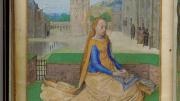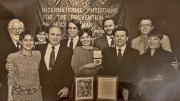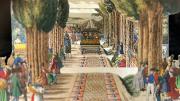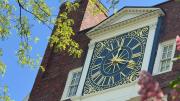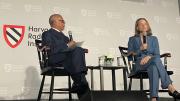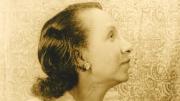In 2000, Jeffrey Hamburger, Francke professor of German art and culture, and William Stoneman, curator of early books and manuscripts at Houghton Library, began unearthing lesser-known medieval manuscripts across the Boston area. This week, their efforts culminate with the opening of “Beyond Words: Illuminated Manuscripts in Boston Collections,” at three Boston sites. Manuscripts created for laypeople are on display at Boston College’s McMullen Museum of Art, and Italian humanist texts will be shown at the Isabella Stewart Gardner Museum. The monastic manuscripts are here at Harvard. (For an overview of the exhibition, with multiple images of the works, see “Illuminations,” September-October 2016, page 22.)
Unlike the display spaces at the McMullen, the gallery at Houghton is a space within a library, Stoneman notes. It’s not designed to transform itself around each new exhibition’s contents: the walls stay that same green-pea shade no matter what’s in the glass cases. These books laid out for viewers are both art objects with immense physical presence, and texts responsible for transmitting information. In their glass cases at Houghton, I see them as primarily the former.
These works were born into a world where literacy was scarce and almost universally affiliated with religion: the exhibition description refers to monasticism as, at its heart, a “cult of the book.” I imagine how compelling written religious text would have been to early readers: the words echo off the page, as if read by an invisible voice heard only by you, but are available to other readers as well. The original words had been passed down, as ancient-seeming to the scribes as to us today, infused with the voice of God. In an age when human geniuses were understood as divine conduits, God was the source of all true creation. Today’s individual authors, revered as the sole sources of their works, were unthinkable then. Instead, responsibility for the creation of these manuscripts was diffused among anonymous scribes with many assistants. (Credit is also arguably due to whoever slaughtered the calves and prepared the vellum for the pages.) Manifold individuals took part in the collective creation—the most recent physical instantiation—of a text much larger and more ancient than themselves.
Before the widespread use of movable type in the fifteenth century, “the concept of copyright, let alone plagiarism, made no sense,” writes Hamburger in his essay, “Authors & Readers,” in the exhibition catalog, and book theft was prevented with chains; now we have digital-rights management and lawsuits. A display of several volumes chained and shut, shielding their contents, greets visitors at the door. For Stoneman, the chains represent the value the works’ makers assigned to them: a reminder that each is unique, laboriously produced, held close, and dear. But other chains are invisible: even today, one of the manuscripts on display—the ornately bordered Book of Hours from the Harry Elkins Widener Memorial Collection—cannot leave its home library. To include it, the curators had to negotiate to lengthen its testamentary tethers: Houghton was designated an extension of Widener, allowing the manuscript to be moved barely a hundred yards east. Literal and figurative chains have a paradoxical function: they safeguard these scarce volumes from wandering fingers, and that security makes access possible.
But the book in a glass case poses a challenge. The rigors of proper conservation do not allow us the privilege of leafing through fragile pages. Intricate artworks are shut up in the pages we cannot see. Those on display, even when chosen with nuance and care, leave the viewer with only a small cross-section of the manuscripts’ contents. Stoneman—for whom the chance to turn the pages is one of the choice privileges of his position—and the other curators debated these decisions extensively. Companion iPads on black stands (Stoneman aptly notes their resemblance to mushrooms growing out of the gallery floor in the interstices between the glass cases) offer digital facsimiles of several additional pages: a compromise giving viewers a glimpse without disturbing the delicate volumes themselves.
The exhibition has catalyzed the digitization and conservation of many of the included works. These digital replicas will sample sections of the manuscript hidden beneath the pages chosen for display, translated into contemporary English and annotated; now infinitely duplicable, converted into ones and zeroes, the manuscripts’ contents are ready for wide dissemination. The digital element of the exhibition seems ironic: the invaluable and singular manuscripts on display embody the qualities of the book lost to the democratized world of PDFs and Kindles—not only heft, but also labor. Each of these objects required long hours of meticulous character-by-character copying on the part of generations of scribes, most of them monks taught calligraphy as part of their daily labors. Scribes not only copied characters but also (like the curators) added extensive commentary, analysis, and translations of words that, even then, were anachronisms. All this was painstakingly traced around the large red stanzas of the original in tiny script—miniature black lines of annotation printed between the larger red ones, dense blocks of commentary in the margins.
The manuscripts’ great decorated initial capitals are a constant reminder that letters are first and foremost shapes with their own physicality. The scribe who adorned a red and yellow E with “voids filled with dots, dashes, and squiggles” (as Hamburger describes them in “Authors & Readers”) caressed that E onto the page. How far can you mutate an E before it ceases to be an E? You can live in these letters: a king and two boys inhabit the curve of an enormous T. Here type conventions are formed not through an Apple employee’s decision about which fonts to preload, but through consensus reached among generations of monks, each the master of multiple scripts and styles.
The medieval works Stoneman and his colleagues have gathered are fascinating independent of their status as heirlooms fetishized by the nineteenth-century Boston Brahmins who first collected them. They have something to tell us about a time when books were sparse and their creation laborious—if we read between the lines. For those of us with full shelves, the Houghton Library exhibit offers a chance to consider the scarce ancestors of today's books: the text before the invention of the author, the table of contents, or the index. In the Middle Ages, painstaking imitation was not only the sincerest form of flattery but vital to preventing the extinction of these works.
